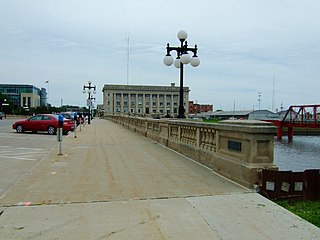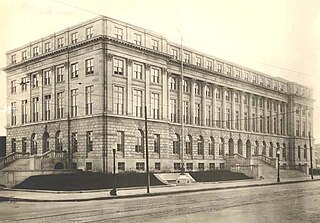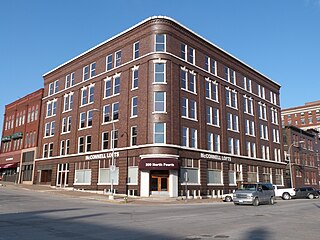
The Des Moines County Court House located in Burlington, Iowa, United States, was built in 1940. It was listed on the National Register of Historic Places in 2003 as a part of the PWA-Era County Courthouses of Iowa Multiple Properties Submission. The courthouse is the fourth structure to house court functions and county administration.

The Warren County Courthouse is located in Indianola, Iowa, United States. The courthouse that was built in 1939 was listed on the National Register of Historic Places (NRHP) in 2003 as a part of the PWA-Era County Courthouses of IA Multiple Properties Submission. It was the third building the county has used for court functions and county administration. The building was demolished in the summer of 2019 and removed from the NRHP in September of the same year. A new courthouse and justice center is expected to be completed in 2022.

Proudfoot & Bird was an American architectural firm that designed many buildings throughout the Midwest region of the United States. Originally established in 1882, it remains active through its several successors, and since 2017 has been known as BBS Architects | Engineers.

The Keokuk County Courthouse located in Sigourney, Iowa, United States, was built in 1911. It was individually listed on the National Register of Historic Places in 1981 as a part of the County Courthouses in Iowa Thematic Resource. In 1999 it was included as a contributing property in the Public Square Historic District. The courthouse is the fourth building the county has used for court functions and county administration.

The Lee County Courthouse is located in Fort Madison, Iowa, United States. The courthouse serves the court functions and county administration for the northern part of Lee County, and it is the county's first courthouse. It was listed on the National Register of Historic Places in 1976 as a part of the County Courthouses in Iowa Thematic Resource. In 2014, it was included as a contributing property in the Park-to-Park Residential Historic District. Southern Lee County is served from a courthouse in Keokuk in the former Federal Courthouse building.

The Des Moines City Hall is a government building in Des Moines, Iowa, built in 1909 and 1910. It was individually listed on the National Register of Historic Places on November 10, 1977 as the Municipal Building, and became a contributing property in the Civic Center Historic District in 1988. The building serves as the seat for the government of the city of Des Moines. Beginning April 7, 2016, City Hall offices were temporarily relocated while the building underwent renovation. The construction was necessary to install modern heating, cooling, and sprinkler systems while preserving the historic character of the building. The project was expected to take 18–24 months. During that time, City Hall was closed to the public, and City offices moved to other nearby locations. Between February 26, 2018 and April 9, 2018, city offices moved back to City Hall.

The Old Downtown Des Moines Library is a historic building in downtown Des Moines, Iowa, United States that was built in 1903. It was individually listed on the National Register of Historic Places in 1977, and became a contributing property in the Civic Center Historic District in 1988. The building ceased to be a library in 2006 and now houses the Norman E. Borlaug | World Food Prize Hall of Laureates for the World Food Prize.

The Dallas County Courthouse in Adel, Iowa, United States was built in 1902. It was individually listed on the National Register of Historic Places in 1973, and is a part of the County Courthouses in Iowa Thematic Resource. In 2009 it was included as a contributing property in the Adel Public Square Historic District. The current structure is the fourth building to house court functions and county administration.

Ottumwa Public Library is a public library located in downtown Ottumwa, Iowa, United States. The current building was built in 1901. It is part of the Central Park area, which is the civic center of the community. It includes the Wapello County Courthouse, Ottumwa City Hall, and St. Mary of the Visitation Catholic Church. The library was listed on the National Register of Historic Places in 1984.

The Chautauqua Park Historic District is located on the north side of Des Moines, Iowa, United States. It has been listed on the National Register of Historic Places since 1990. It is part of the Suburban Development in Des Moines Between the World Wars, 1918--1941 MPS.

The Civic Center Historic District is located in downtown Des Moines, Iowa, United States. It flanks both the Des Moines and Raccoon Rivers and their confluence. The district has been listed on the National Register of Historic Places since 1988. It is part of The City Beautiful Movement and City Planning in Des Moines, Iowa 1892—1938 MPS.

The United States Post Office is an historic building located in Des Moines, Iowa, United States. It was individually listed on the National Register of Historic Places in 1974. It became a contributing property of the Civic Center Historic District when it was established in 1988. It now houses administrative offices for Polk County.

The United States Courthouse, located in Des Moines, Iowa, is the headquarters for the United States District Court for the Southern District of Iowa. It is part of the Civic Center Historic District that was listed on the National Register of Historic Places in 1988.

The Dickinson County Courthouse is located in Spirit Lake, Iowa, United States. Built in two phases in 2006 and 2009, it is the fourth building to house court functions and county administration.

The Downtown Commercial Historic District encompasses most of the central business district of Burlington, Iowa, United States. It was listed on the National Register of Historic Places in 2015. The historic district includes 65 properties that were part of a 2012 to 2013 survey of the area. It also includes as contributing properties the buildings in the West Jefferson Street Historic District and three buildings in the Manufacturing and Wholesale Historic District that were previously listed on the National Register. All total there are 122 resources within the district, which includes 108 contributing and 14 non-contributing properties.

The Manufacturing and Wholesale Historic District is a nationally recognized historic district located adjacent to the central business district of Burlington, Iowa, United States. It was listed on the National Register of Historic Places in 2012. At the time of its nomination it included 32 buildings of which 28 are contributing properties and 14 non-contributing properties. The tracks of the former Chicago, Burlington and Quincy Railroad bisect the district and contributed to its development. The buildings range in size from one single story office structure to two six-story buildings. Nine buildings were constructed before 1900, the earliest in 1876. The rest of the contributing buildings were built from 1900 to the 1930s. The four noncontributing buildings were built from the 1960s to the 1980s. The Romanesque Revival John Blaul and Sons Wholesale Grocery building is the only building that wasn't built in a utilitarian form with only general stylistic influences. All of the buildings are constructed in brick. The area largely housed manufacturing and wholesale businesses into the 1970s and 1980s. A few of them continue to do so into the second decade of the 21st-century.

The Starker–Leopold Historic District is composed of three houses and the surrounding grounds overlooking the Mississippi River in Burlington, Iowa, United States. It was listed on the National Register of Historic Places in 1983. The houses were built by the Starker-Leopold family who lived in them for most of their existence. Charles Starker was a successful Burlington businessman who contributed to public building and park development projects. He worked as an architect, engineer, and merchant before becoming an influential banker. His daughter Clara Starker-Leopold instilled her father's values in her children. Carl Leopold was Clara's husband and a local wood-working businessman and outdoor enthusiast.

Bloomfield Public Library is a public library located in Bloomfield, Iowa, United States. A library in Bloomfield dates back to the 1870s when a library association was established. One had to pay a subscription fee in order to borrow books. The Carnegie Corporation of New York had accepted the Commercial Club of Bloomfield's application for a grant for $10,000 on November 21, 1911. An election on December 30, 1911, approved constructing new public library in town. The building was designed by Frank E. Wetherell of the Des Moines architectural firm of Wetherall and Gage, and contractor C.W. Ennis constructed it. The new library was dedicated on August 8, 1913. The library is a brick, side gable structure with a projecting entrance on the long side of the building. Both the entrance and the side elevations of the building feature Tudor Revival vergeboards and half-timbered gable ends. The collection includes books in large print, regular print, hard back books and paperbacks, movies, and books-on-CD. Other services include public computers, a young adult section, and a children's area. The building was listed on the National Register of Historic Places in 2015.

The First National Bank of Davenport, also known as Brenton Bank and The Brenton, is an historic building located in central Davenport, Iowa, United States. It was listed on the National Register of Historic Places in 2018.

The Iowa City Downtown Historic District is a nationally recognized historic district located in Iowa City, Iowa, United States. It was listed on the National Register of Historic Places in 2021. At the time of its nomination it consisted of 102 resources, which included 73 contributing buildings, one contributing site, one contributing object, 21 non-contributing buildings, and seven non-contributing objects. Eight buildings that were previously listed on the National Register are also included in the district. Iowa City's central business district developed adjacent to the Iowa Old Capitol Building and the main campus of the University of Iowa. This juxtaposition gives the area its energy with the overlap of university staff and students and the local community. The district was significantly altered in the 1970s by the city's urban renewal effort that brought about the Ped Mall, which transformed two blocks of College Street from Clinton Street to Linn Street and Dubuque Street from Burlington Street to Washington Street. It is the contributing site and the large planters/retaining walls that are original to the project are counted together as the contributing object. There are also several freestanding, limestone planters, five contemporary sculptures, and a playground area are the non-contributing objects.
























